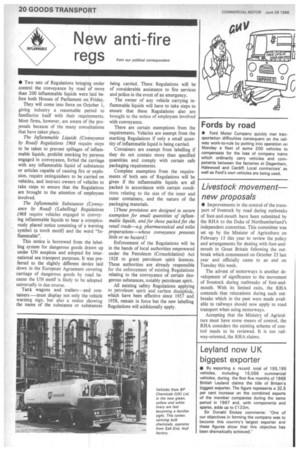New anti-fire
Page 22

If you've noticed an error in this article please click here to report it so we can fix it.
regsfrom our political correspondent
• Two sets of Regulations bringing under control the conveyance by road of more than 200 inflammable liquids were Ilaid before both Houses of Parliament on Friday.
They will come into force on October 1, giving industry a reasonable pe iod to familiarize itself with their requi ements. Most firms, however, are aware of he proposals because of the many cons ltations that have taken place.
The Inflammable Liquids (Co veyance by Road) Regulations 1968 requi e steps to be taken to prevent spillages of inflammable liquids, prohibit smoking by lpersons engaged in conveyance, forbid the earriage with any inflammable liquid of suI;. stances or articles capable of causing fire o explosion, require extinguishers to be carried on vehicles, and instruct owners of vehicles to take steps to ensure that the Regulations are brought to the attention of employees involved.
The Inflammable Substances (conveyance by Road) (Labelling) Regulations 1968 require vehicles engaged in onveying inflammable liquids to bear a c nspieuously placed notice consisting of a varning symbol (a torch motif) and the word "Inflammable".
This notice is borrowed from the labelling system for dangerous goods drawn up under UN auspices and adopted fo international sea transport purposes. It as preferred to the slightly different device laid down in the European Agreement c vering carriage of dangerous goods by rod because the UN motif is likely to be a opted universally in due course.
Tank wagons and trailers—an containers —must display not only the vehicle warning sign, but also a notice showing the name of the substance or substances being carried. These Regulations will be of considerable assistance to fire services and police in the event of an emergency.
The owner of any vehicle carrying inflammable liquids will have to take steps to ensure that these Regulations also are brought to the notice of employees involved with conveyance.
There are certain exemptions from the requirements. Vehicles are exempt from the marking Regulations if only a small quantity of inflammable liquid is being carried.
Containers are exempt from labelling if they do not contain more than specified quantities and comply with certain safe packaging requirements.
Complete exemption from the requirements of both sets of Regulations will be given if the inflammable liquids are all packed in accordance with certain conditions relating to the size of the inner and outer containers, and the nature of the packaging materials.
[These provisions are designed to secure exemption for small quantities of inflammable liquids, and for those packed for the retail trade—e.g. pharmaceutical and toilet preparations—whose conveyance presents little or no hazard I Enforcement of the Regulations will be in the hands of local authorities empowered under the Petroleum (Consolidation) Act 1928 to grant petroleum spirit licences. These authorities are already responsible for the enforcement of existing Regulations relating to the conveyance of certain dangerous substances, notably petroleum spirit.
All existing safety Regulations applying to petroleum spirit and carbon disulphide, which have been effective since 1957 and 1958, remain in force but the new labelling Regulations will additionally apply.
























































































































